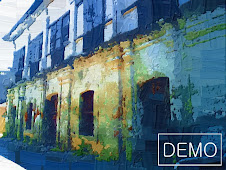 Excerpt from the letter of Ms. Ha of Waseda University, Tokyo, Japan.
Excerpt from the letter of Ms. Ha of Waseda University, Tokyo, Japan....what Vigan is most concerned about are: 1/ ancestral houses have become too much business-like modified that some of them have lost their authentic look; 2/ more rich businessmen from outside (mostly from Manila) are coming to invest in Vigan that local people somehow have to move out or lose many benefits to those people; and 3/ the growing gap between the rich and poor in the city.
My Reply:
1/ ancestral houses have become too much business-like modified that some of them have lost their authentic look;
--First of all, let me tell you that the present state of the ancestral houses are the results of the conservation efforts of the city government to restore the once glorious Spanish city in the Philippines, Ciudad La Fernandina. Before the conservation of the Medina Administration (couples Eva Marie Singson Medina and Ferdinand Cruz Medina), the old Spanish Ancestral houses have been dilapidated and unkempt. They ahve been abandoned by their owners and left to caretakers. What you see now along the kilometer length of Calle Crisologo is the original street formerly known as the Kasanglayan District or "Chinese" District where once the enterprising Chinese traders lived and established their families. It was the Chinatown of the North during its time. So that whatever commercialism there is today is not "new." It has always been a commercial district. In fact, it was called "Escolta" the same trading center place in Manila wherem yes, Chinese abound.
--The new commercial establishments seen in the city right now are newly erected buildings constructed based on the design of the ancestral houses, a pre-requisite design for buildings that are to be built within the designated core zone of the city. Some of such establishments are the Jolibee, McDonalds and the new Two Brothers Grocery. The city government is very much in control of the constructions taking place in the core zones so as to preserve the original structures. Some restoratuve works were done, cleaning so to speak as these houses have been rented out as warehouses by their owners when they left for abroad.
2/ more rich businessmen from outside (mostly from Manila) are coming to invest in Vigan that local people somehow have to move out or lose many benefits to those people;
While it may be true that "rich" businessmen have come to invest in Vigan, the local people did not have to "move out or lost many benefits..." The investment climate prevailing in Vigan is in tune with the urbanization that is taking place in this young city. The existence of modern amenities have not dislodged local people but have in fact added more clientele as more people from neighboring towns and provinces come to Vigan, adding to the number of spenders in the area, benefitting everyone doing business.
3/ the growing gap between the rich and poor in the city.
Statistics show that this is not true. Vigan City continues to show as having the lowest incidence of poverty in the Region. And it will always remain as such, considering the many Poverty-Alleviation programs being embarked by the city governemnt through its livelihood projects, skills enhancement meant to empower the people earn a living, both locally and internationally.
In my next posts, I will tackle the many Anti-Poverty Projects of the City. Hang on..





No comments:
Post a Comment